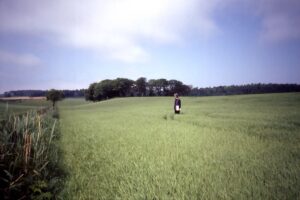
Sites are key to the work of an archaeologist. But what, exactly, do we mean by a site? It is a term that we use all of the time, but it has become so commonplace that we rarely stop to consider what we are talking about. It is worthwhile pausing and reflecting.
It is a complicated situation from the start. When an archaeologist talks about a site, they might mean one of two things:
- A location of interest in the present day – a place where archaeological material occurs, and which has the potential for visiting and, possibly, investigation.
- A location of interest in the past – a place where people did things.
I’ve covered the latter definition and the problems we encounter when trying to weigh up the relative significance of locations in previous blog entries. But I have also been thinking about the former in relation to the project I’m working on just now. And, the two blur together.
The issues relate to a fieldwalking project in farmland outside Aberdeen. The location of all the individual finds has to be recorded and the easiest way to do this is, of course, with a dGPS, but we also need a shorthand way in which to know how different groups of finds might relate to other groups. The most obvious method is to relate the finds to the fields in which they have been picked up. This tried and tested method has been used successfully for over a century; fields have names and you will find that most fieldwalking projects use them to refer to individual ‘sites’.
It works. Or does it?
There are some problems.
Field boundaries are not static and when a project takes place over a number of years some of these boundaries, inevitably, change. Fields often become bigger: two ‘sites’ may be amalgamated into one. On occasion they are subdivided: one ‘site’ may become two. In addition, it is not uncommon to walk one field and then, perhaps a few years later when the adjacent field is ploughed, that might be walked as well. If two similar assemblages are found in the adjoining fields, does that mean that there are two sites? Or is it really one site? The boundaries of today are, after all, modern constructs that have no relation to the communities of prehistory.
The nomenclature can become difficult and it only gets more complex as, with time, more and more of the countryside is covered. Gradually, a nice mosaic of individual field ‘sites’ will blur into a broader spread with varying lithic densities and contents across the land. At this point, careful record keeping, while tricky, becomes vital. We need to know where the evidence has been found, but the analysis has to expunge the modern boundaries if it is to provide a valid interpretation of the past.
As you see, our instinctive use of the word site is laden with issues. I’m not sure at this stage that we can resolve them. It is too deeply embedded into the archaeological consciousness for us to change our conversation and use terms like research locus, or activity spot – and both of those sound horribly jargonistic and pedantic. But I do think it is useful to be careful that we say what we mean to say. We need to be clear. What are we talking about when we say ‘site’?
- Do we mean the individual field?
- Do we mean the geographic focus of our research?
- Do we mean the general farm or community where the finds have been made?
- Do we mean the spot where people did something in prehistory?
It is no bad thing to remind ourselves that the names we give are always modern and relate more to our own use of the land than use in the past. It is no bad thing to remind ourselves that we need to be clear about what we mean. And it is certainly no bad thing to remind ourselves of the importance of accurate and comprehensive record keeping.
In this way it is possible to build a picture of the ways in which people have used the landscape of the past and, if you are lucky, to visualise this behind the landscape that meets the eye today.
You must be logged in to post a comment.